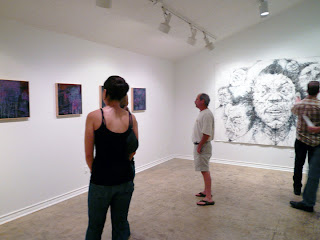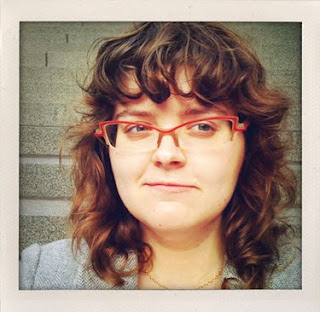CHICAGO BUILD UP
by Pedro Vélez
I think I’ve had it with apartment galleries and alternative spaces, which have been one of the Chicago art scene’s special attractions for so many years. Trust me, I used to run one in the late ‘90s. Chicago has been there, done that, and even reinvented the brand. And as if to prove it,
Allison Peters Quinn and
Briton Bertran organized
"Artist Run Chicago" at the
Hyde Park Art Center last spring, a magnificent look back at a decade of such noteworthy hubs as
Joymore,
NFA Space (which showed
Luis Gispert),
Dogmatic (where
Paul Chan started),
Green Lantern,
Polvo and
Law Office "Artist Run Chicago" also posed one important question: Now what? In New York, young galleries grow into new powers. Chicago has a couple of museums and a couple of good galleries, but they’re stops on the international circuit rather than incubators of local talent. You can have museum shows here and never sell a thing. Let’s be honest, alienation can be depressing.
Well, Chicago can’t exactly fall back on its reputation as a world art center, like New York can. But it wasn’t all bad news. Here’s a brief retrospective of notable 2009 art events in the city.
Michigan Avenue
My top choice is rather predictable: The opening of the
Art Institute of Chicago Modern Wing.
Renzo Piano’s critically acclaimed, $300-million-plus, 264,000-square-foot addition to the AIC now stands alongside
Wrigley Field and the
Willis Tower (formerly
Sears Tower) as a must-see destination on every tourist list. But what about the locals? At $18 per person, it’s cheaper for a family of four to go to a baseball game than to enjoy a day of culture.
Me, I got my kicks for free (thanks,
AICA), especially from
Cady Noland’s
OOZEWALD (1989), which looks grandiose inside Piano’s glass cathedral. The cut-out newspaper image of Oswald, at the moment of his assassination, peppered with oversized bullet holes, gagged with a U.S. flag, resonates today more than ever, given the Supreme Court’s gut-wrenching decision to turn the election process over to deep-pocketed corporations. It is also a sad reminder of how
Barack Obama upholds the Bush Doctrine while the American voter plays the role of captive audience.
Cleverly installed next to Noland was
Sue Williams’ early psycho-narrative
It’s a new age (1992)
, a painting that dirties up the place with its beautiful yet aggressive take on misogyny. "I chose fat thighs," it reads, "ass holes, sew ‘em up." The experience is like watching hardcore porn starlet
Sasha Grey going mainstream in the
Girlfriend Experience.
Across the street from the Art Institute is the
Museum of Contemporary Photography, which did better with Chicago talent with its "Midwest Photographers Project," which featured
Stacia Yeapanis,
Curtis Mann (selected for the
2010 Whitney Biennial) and
John Opera, the stand out, in a show called "MP3." Opera juxtaposes small geometric abstractions with large, sleek and threatening visions of nature.
Close by on Washington Street the
Chicago Cultural Center hosted
FMEL, a two-day "Festival de Musica Electronica Latina" that ran concurrently at the
National Museum of Mexican Art in the neighborhood of Pilsen. Among the participants were the respected sound artist
Manrico Montero, founder of net label
Mandorla, and the New York-based ambient duo
Arturo en el Barco (
José Olivares and
Angélica Negrón).
The couple -- a sort of adorably geekier version of
Thurston Moore and
Kim Gordon -- played an intimate live set by building sounds digitally using diverse objects (a music box, bubble wrap, toy instruments) to make dreamy and emotional compositions that were quite capable of elating the crowd.
The West Loop
Sarah Hicks proved herself a force to be reckoned in her first solo exhibition at
Thomas Robertello Gallery. Seductive, erotic and borderline decorative, Hicks’ brightly glazed ceramics are small objects suggestive of bits of coral reef, alien life forms and sex toys, were exhibited placed on top of a glass table. It was a strange brew of forms.
Another young artist to make an impact was my good friend
Joseph Hardesty at
Western Exhibitions (the gallery that represents me). Hardesty’s delicate handmade renderings on paper, almost transparent, of phrases, statements and verses seem to fade in and out, and exude a certain insecurity. The artist, who spent a year in Berlin thanks to a
Gelman Travel Fellowship, articulates his feelings through vivid narrative metaphors involving horses, Vikings, gray cobblestones and flying monkeys.
Next door, at
Three Walls, the renowned nonprofit cultural platform and residency, the art producer, DJ and all around personality
Philip von Zweck had a suite of pretty, clumsy and conceptual figurative paintings that served as backdrop for a series of lectures organized specifically for the occasion.
Censorship on the South Side
Controversy is never in shortage when it comes to Chicago’s police and politicians. Such was the case when a mural by
Gabriel Villa in the ethnically varied neighborhood of Bridgeport -- a mural, not graffiti -- was erased under the orders of alderman
James Balcer. True, the artwork did show Jesus crucified on top of a CPD blue-light camera surveillance box, but it was privately commissioned for private property.
"I believe that was a threat," Balcer told the local news. "The dead deer, the skull, the cross, RIP, rest in peace was in there, that symbolizes death. And I don't know if it will incite gang violence or more trouble." Sad, that Latino religious iconography and customs celebrating the dead, not to mention urban displays of social discomfort on Chicago’s South Side, should provide an excuse to exercise bias and art censorship.
The incident is especially ironic considering the hopeful words from
National Endowment for the Arts director
Rocco Landesman quoted in the
Chicago Tribune on Aug. 27. "Chicago has a mayor who sees the value of art in urban areas," Landesman said. "We have a president who is a writer, an artist, who gets artists. We have a first lady who understands the importance of the arts in education. We have a new era coming. Chicago will be ground zero."
Luckily,
Antena, a space in Pilsen run by artist
Miguel Cortez and one of the best the city has to offer, did not wait on Rocco’s promises and mounted an impressive survey of Villa’s large-scale drawings, as well as a recreation of the original lost work.
Off the Loop
Honorable mentions go to
"This Shadow Is a Bit of Ideology"at
UIC 400 and the
Davis Langlois show at the
Chicago Cultural Center which I wrote about last March;
Merchant Adams for his
hilariously serious mutations of stuffed animals representing racial mixes produced by the Spanish colonization of the Americas at
Prak-sis; and
Chelsea Knight’s
"I Lay Claim to You"(with
Khalia Frazier), a joyous single video projection of a dance loosely based on
Margaret Mead’s 1938 description of a Balinese cremation at
Julius Caesar.
Also,
Deb Sokolow’s
site-specific diagram about her Jewish heritage, and the fictitious narratives elaborated over corned beef at the
Spertus Museum; and
Dann Gunn’s post-minimalist constructions at
Lloyd Dobler. In the end, nothing was as exciting as
White Sox ace
Mark Buehrle’s no-hitter on July 23 against the
Tampa Bay Devil Rays. Twenty-seven batters retired -- a true masterpiece.
"Italics" at the MCA
Last but not least, a show that remains open for the upcoming
College Art Association 2010 Annual meeting Feb. 10-13, 2010, is star curator
Francesco Bonami’s
"Italics: Italian Art between Tradition and Revolution, 1968–2008," Nov. 14, 2009-Feb. 14, 2010, at the
Museum of Contemporary Art. Bonami, who during his tenure as MCA senior curator made quite an impression on the local artists by never leaving his office, originally presented this show at the
Palazzo Grassi in Venice, where it was met by a barrage of negative reviews.
The revisionist survey pretends to make a political statement by salvaging lesser-known artists from the annals of Italian history. Bonami has washed his hands publicly on this issue, claiming that he is not a historian. We couldn’t agree more; he is more like a
Sergio Leone of curators, presenting canned Italian culture for American audiences. But for a show that insists in resurfacing underrated or unknown names, it begins curiously with current market favorite
Maurizio Cattelan.
Overall, "Italics" is not bad; it’s a dynamic ride, and most viewers could find something amazing in the 75-plus artist lineup. My favorite is
Compagni, Compagni (1968) by bad-boy ‘60s painter
Mario Schifano (1934-98), a spray-painted monochrome encased in translucent red plastic, depicting three silhouettes of "comrades," in this case seeming to be Vietnamese peasants (typically they hold a hammer and sickle, symbols of the "just solution to social contradictions," as Schifano inscribed other versions of the image).
Schifano, who might be called the Italian
Andy Warhol -- which would make him a lover as well as a Pop artist; he supposedly stole
Marianne Faithfull from
Mick Jagger -- also made art from commercial logotypes, put on music events and made video art, and in 1967 released one great psychedelic recording,
The Stars of Mario Schifano. It has an astonishing 17-minute-long jam or freak-out session comparable to the styling of
Arthur Brown or the
13th Floor Elevators.
PEDRO VÉLEZ is an artist and critic living in Chicago
http://www.artnet.com/magazineus/reviews/velez/chicago-build-up1-29-10.asp
 Cumpián is also the editor of March Abrazo Press, which has been instrumental in the longevity of the small press and establishing its presence as an independent publisher of Latino and Native American poetry.
Cumpián is also the editor of March Abrazo Press, which has been instrumental in the longevity of the small press and establishing its presence as an independent publisher of Latino and Native American poetry. The University of Illinois in Chicago and would later teach both subjects for over a decade at Truman College. Since 2009 she has resided in Santa Fe. She edited and co-funded the bilingual publication ¿Hasta Cuándo? which is now online. She writes poetry, book reviews and articles for Polvo, Area, Lumpen times and Contratiempo magazines. Considering poetry as a form of expression that crosses cultures as well as space and time, her poetry is a process of thoughts and images, which arrange themselves in words and worlds.
The University of Illinois in Chicago and would later teach both subjects for over a decade at Truman College. Since 2009 she has resided in Santa Fe. She edited and co-funded the bilingual publication ¿Hasta Cuándo? which is now online. She writes poetry, book reviews and articles for Polvo, Area, Lumpen times and Contratiempo magazines. Considering poetry as a form of expression that crosses cultures as well as space and time, her poetry is a process of thoughts and images, which arrange themselves in words and worlds.




























